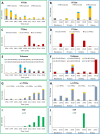Retrospective Identification of Novel and Legacy Per- and Polyfluoroalkyl Substances in German Archived Fish Livers Using a Combined High-Resolution Mass Spectrometry Approach
- PMID: 40539878
- PMCID: PMC12224335
- DOI: 10.1021/acs.est.4c11600
Retrospective Identification of Novel and Legacy Per- and Polyfluoroalkyl Substances in German Archived Fish Livers Using a Combined High-Resolution Mass Spectrometry Approach
Abstract
Per- and polyfluoroalkyl substances (PFAS) are persistent environmental pollutants with many unknown variants, posing potential ecosystem and human health risks. To comprehensively assess PFAS contamination and overcome the challenge of unknown PFAS identification, we combined Fourier transform ion cyclotron resonance mass spectrometry (FT-ICR MS) and liquid chromatography─quadrupole time-of-flight mass spectrometry (LC-QTOF MS) to identify novel and Legacy PFAS in archived bream liver samples collected in Germany between 1996 and 2020. By leveraging the ultrahigh resolution and mass accuracy of FT-ICR MS, we generated a mass list for cross-comparison with common precursor ion features from LC-QTOF MS. We identified 78 PFAS, including 68 classified into 12 homologue groups and 10 that did not fit into any homologue series, encompassing perfluoroalkyl acids, fluorotelomer-based substances, pentafluorosulfide perfluoroalkyl sulfonic acids, polyfluoroalkyl sulfinates, polyfluoroalkyl sulfonyl sulfonamides, and other novel compounds including ionic liquids. Spatial and temporal analysis revealed that perfluoroalkyl phosphinic acids (C6/C6, C6/C8) and polyfluoroalkyl sulfonic acids (n = 10) have a widespread presence, whereas tris(pentafluoroethyl)trifluorophosphate (FAP) and polyfluoroalkyl sulfonyl sulfonamides (n = 6) are more localized or have only recently emerged in specific regions. These findings underscore the need for continued monitoring to comprehensively understand exposure to PFAS and their long-term environmental impact.
Keywords: FT-ICR MS; LC-QTOF MS; fluorinated ionic liquids; freshwater fish; per- and polyfluoroalkyl substances.
Figures

References
-
- Buck R. C., Franklin J., Berger U., Conder J. M., Cousins I. T., De Voogt P., Jensen A. A., Kannan K., Mabury S. A., Van Leeuwen S. P.. Perfluoroalkyl and Polyfluoroalkyl Substances in the Environment: Terminology, Classification, and Origins. Integr Environ. Assess Manag. 2011;7(4):513–541. doi: 10.1002/ieam.258. - DOI - PMC - PubMed
-
- Göckener B., Fliedner A., Rüdel H., Badry A., Koschorreck J.. Long-Term Trends of Per- and Polyfluoroalkyl Substances (PFAS) in Suspended Particular Matter from German Rivers Using the Direct Total Oxidizable Precursor (dTOP) Assay. Environ. Sci. Technol. 2022;56(1):208–217. doi: 10.1021/acs.est.1c04165. - DOI - PubMed
-
- Rupp J., Guckert M., Berger U., Fu Q., Nodler K., Nurenberg G., Koschorreck J., Schulze J., Reemtsma T.. Long term trends of legacy per-and polyfluoroalkyl substances (PFAS), their substitutes and precursors in archived wildlife samples from the German Environmental Specimen Bank. Environment International. 2025;201:109592. doi: 10.1016/j.envint.2025.109592. - DOI - PubMed
-
- Duffek A., Conrad A., Kolossa-Gehring M., Lange R., Rucic E., Schulte C., Wellmitz J.. Per- and Polyfluoroalkyl Substances in Blood Plasma - Results of the German Environmental Survey for Children and Adolescents 2014–2017 (GerES V) International Journal of Hygiene and Environmental Health. 2020;228:113549. doi: 10.1016/j.ijheh.2020.113549. - DOI - PubMed
MeSH terms
Substances
LinkOut - more resources
Full Text Sources
Miscellaneous

